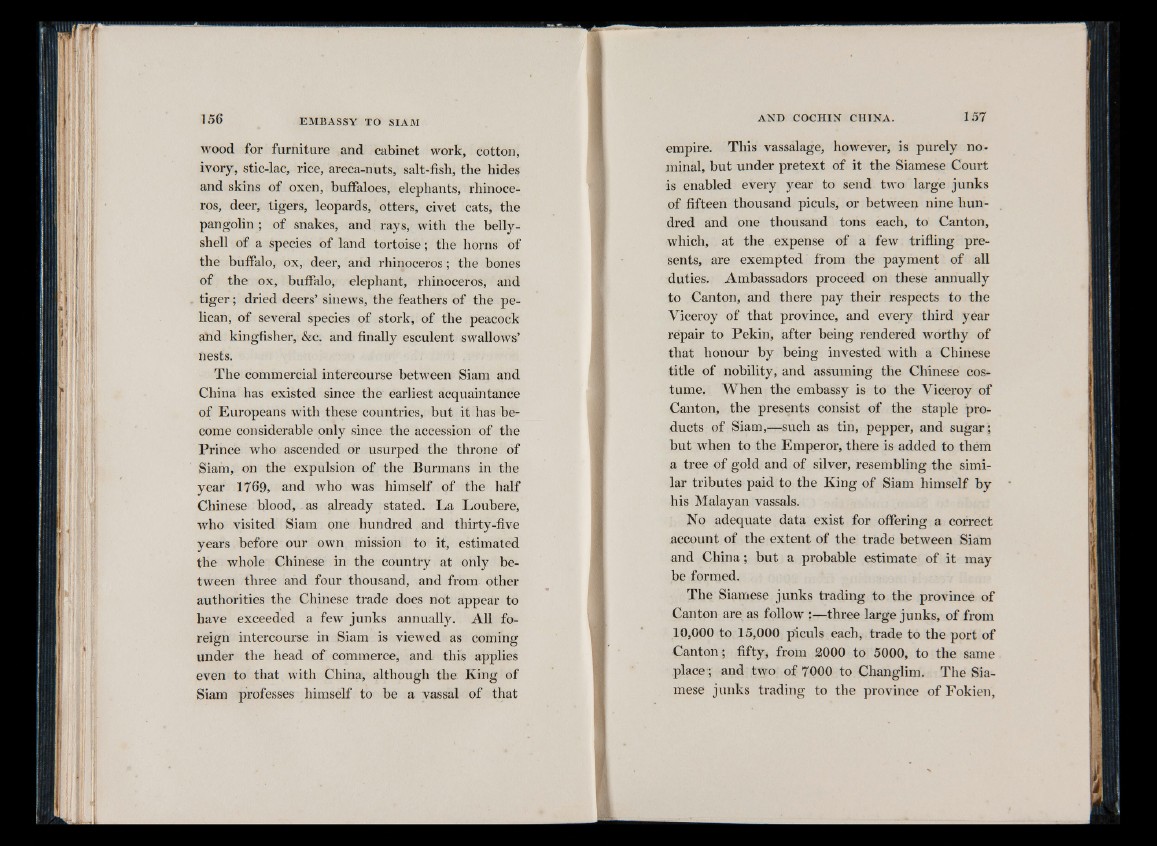
wood for furniture and cabinet work, cotton,
ivory, stic-lac, rice, areca-nuts, salt-fish, the hides
and skins of oxen, buffaloes, elephants, rhinoceros,
deer, tigers, leopards, otters, civet cats, the
pangolin ; of snakes, and rays, with the belly-
shell of a species of land tortoise; the horns of
the buffalo, ox, deer, and rhinoceros; the bones
of the ox, buffalo, elephant, rhinoceros, and
tig e r; dried deers’ sinews, the feathers of the pelican,
of several species of stork, of the peacock
and kingfisher, &c. and finally esculent swallows’
nests.
The commercial intercourse between Siam and
China has existed since the earliest acquaintance
of Europeans with these countries, but it has become
considerable only since the accession of the
Prince who ascended or usurped the throne of
Siam, on the expulsion of the Burmans in the
year 1769, and who was himself of the half
Chinese blood, as already stated. La Loubere,
who visited Siam one hundred and thirty-five
years before our own mission to it, estimated
the whole Chinese in the country at only between
three and four thousand, and from other
authorities the Chinese trade does not appear to
have exceeded a few junks annually. All foreign
intercourse in Siam is viewed as coming
under the head of commerce, and this applies
even to that with China, although the King of
Siam professes himself to be a vassal of that
empire. This vassalage, however, is purely nominal,
but under pretext of it the Siamese Court
is enabled every year to send two large junks
of fifteen thousand piculs, or between nine hundred
and one thousand tons each, to Canton,
which, at the expense of a few trifling presents,
are exempted from the payment of all
duties. Ambassadors proceed on these annually
to Canton, and there pay their respects to the
Viceroy of that province, and every third year
repair to Pekin, after being rendered worthy of
that honour by being invested with a Chinese
title of nobility, and assuming the Chinese costume.
When the embassy is to the Viceroy of
Canton, the presents consist of the staple products
of Siam,—such as tin, pepper, and sugar;
but when to the Emperor, there is added to them
a tree of gold and of silver, resembling the similar
tributes paid to the King of Siam himself by
his Malayan vassals.
No adequate data exist for offering a correct
account of the extent of the trade between Siam
and China; but a probable estimate of it may
be formed.
The Siamese junks trading to the province of
Canton are as follow :—three large junks, of from
10,000 to 15,000 piculs each, trade to the port of
Canton ; fifty, from 2000 to 5000, to the same
place; and two of 7000 to Changlim. The Siamese
junks trading to the province of Fokien,